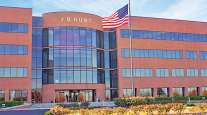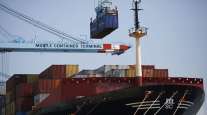Experts Paint Grim Picture for Intermodal Growth

Noel Perry and Larry Gross, both of whom are officials at consultant FTR, were joined by a Wall Street analyst in assessing the future for an intermodal industry whose volumes have shrunk for four consecutive quarters after 23 straight growth periods that included market share gains during the last recession. The three officials spoke at the Intermodal Expo here.
Perry, an economist and former official at Schneider and CSX, said a recession is “highly likely” as early as next year simply because the current recovery has run its course.
“It is likely to be difficult times for intermodal and trucking,” Perry said. “If we have a recession, traffic won’t come back quickly. Very likely your volumes won’t be much higher than they are now.”
At most, Perry said he expects 1.1% intermodal growth two or three years from now, far below the steady growth pace in the 3% to 5% range since the recession began and for most years before.
Brandon Oglenski, director of research at Barclays Capital Inc., didn’t forecast much improvement in the ocean freight sector that feeds intermodal due to competitors’ willingness to keep building ever-larger ships faster than freight volumes increased.
“The [liner] industry is on an unsustainable path,” he said, with the recent Hanjin Shipping bankruptcy that is “more of a symptom than a solution.”
Gross, another FTR official who also previously was an industry executive, pinpointed two recent indicators that are hurting the truck/rail sector — a shift in inland movements of international freight and a sharp dropoff in intermodal trailer shipments by truckers.
“Inland intermodal has become uncoupled from the port sector,” Gross said, compared with past years when intermodal freight moved in “lock step” with import statistics. This year, imports have risen 1.6%, but inland moves of international cargo via intermodal are off 4.5%.
On the domestic front, the 29% decline in intermodal trailer shipments is a “canary in the coal mine,” because truckers who own that equipment can choose to run over the road instead of truck/rail service.
Truckers could be taking advantage of lower fuel costs, he said. Shippers also could be transloading more international freight into domestic trailers and containers before it moves out of port regions, he said.
Even after Hanjin’s Aug. 31 bankruptcy that reduced capacity, Oglenski said he believes the vessels already built and on order will keep adding capacity at a 4% to 5% rate for the next four or five years. Part of the issue, he said, is that carriers owned by sovereign nations, like China, rather than the private sector view transport as an extension of their export policy, which doesn’t have to be profitable.
From the railroads’ perspective, Gross said “intermodal has a tall task ahead,” because even if growth resumes, intermodal generates about 70% less revenue per shipment, so it won’t be able to make up for losses in other rail freight that has been on decline, such as coal.
There were a few bright spots.
Gross said he does believe that U.S. domestic intermodal will be resilient enough to move 2.4% more freight next year despite those trends, compared with the 3% decline year-to-date from 2015. Oglenski believes long-term conversion of highway freight to intermodal is likely.
Over the long-term, Perry sketched a different scenario.
Autonomous vehicles pose an even greater challenge for intermodal, Perry said. The result of growing automation of all trucking-related functions could wind up lowering truckers’ costs by half. That would ruin the longhaul rail savings versus trucks that have been the foundation of intermodal growth.
There are opportunities for intermodal providers to cut costs in closed locations such as yards before highway trucking costs fall.
“Your business has the opportunity to be ahead of the over-the-road trucker because you can bring your costs down faster,” Perry said. “You guys will have to hustle with technology.”
Perry said the “good side” of the future intermodal picture likely could come from the effect of new regulations such as electronic logging devices that promise to turn today’s abundant capacity into a shortage that will cause a rush of driver hiring to counter lost utilization.
“Next time this year we are going to be hiring like crazy,” he said, foreseeing a squeeze on capacity of about 3% to 4%, which is enough to upset the current market.




